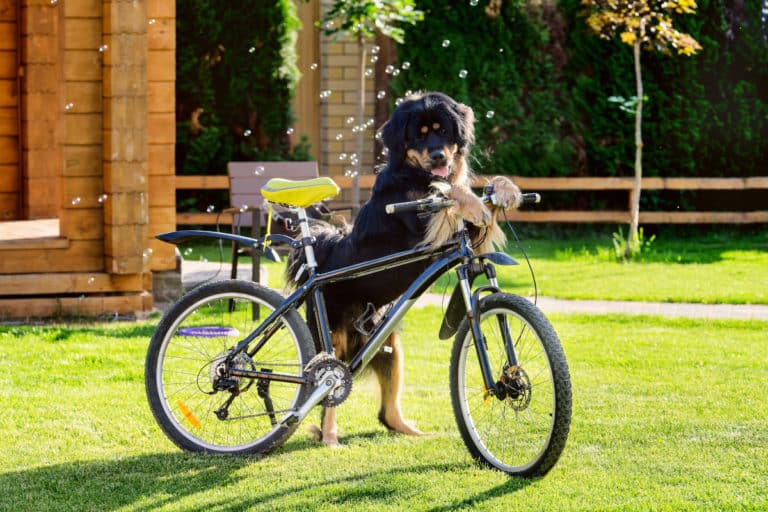Tibetan Mastiffs are smart dogs that you’ll have to earn their respect before they listen to you. That’s one of the reasons why first-time owners are advised not to bother with them just yet. They’re not the affectionate, cuddly types.
Aside from having the resources, experience is a necessity in handling a Tibetan Mastiff. You’re going to need all the help you can get to make things work. But once a Tibetan Mastiff starts to recognize you as a pack leader, his loyalty won’t waver.
How Smart Are Tibetan Mastiffs?
Tibetan Mastiffs are smart to a fault. Their high IQ can lead to stubborn behavior. You need to work to make them follow commands.
They’re also independent. A Tibetan Mastiff will not automatically recognize you as a pack leader. You have to earn it.
Their intelligence is a double-edged blade. It’s not a piece of cake to train them. But things can turn around and work in your favor when the training becomes successful.
Why Is My Tibetan Mastiff So Dumb?
The word dumb doesn’t come into mind when describing a Tibetan Mastiff. When he refuses to follow a command, he’s usually doing it out of stubbornness. Not because of a lack of intellect.
But if he’s showing signs of clumsiness, a health issue may have stunted his development. So if you suspect that he’s having trouble with learning, seek professional help. This will help you address any underlying issue that might have affected his learning skills.
Are Tibetan Mastiffs Independent?
Tibetan Mastiffs are independent dogs. They prefer to get busy with their own thing instead of cuddling around with their owners. They would walk and sniff around your household or sleep when they don’t feel like doing stuff.
The downside is, that Tibetan Mastiffs don’t like the absence of their owners. So long periods without your presence will bother them. They’re not big fans of cuddling but it gives them some sense of peace when you’re around.
Despite being smart and independent, the boredom they feel during an owner’s absence can be problematic. They would start barking, digging, and show signs of aggression. But the right toys and routines could help them combat boredom.
How Stubborn Are Tibetan Mastiffs?
Tibetan Mastiffs are pretty stubborn by default. This is due to their independent nature and high intelligence. Their level of stubbornness will depend on how domesticated and trained they are.
The lack of training can make one even more stubborn. They can be a pain to deal with but you have to be patient. You should get some help from a trainer if things get a little frustrating.
As an owner, you have to qualify as a pack leader in your Tibetan Mastiff’s eyes. You cannot rush or force the process by yelling and being aggressive yourself. This is dangerous because using force can lead to anxiety or aggression.
Take things slowly and find the perfect balance. Being cuddly won’t make him respect you either as you’d look weak or a pushover. Slow progress is still better than rushing the training.
How Do You Train a Stubborn Tibetan Mastiff?
Early on, you should let your Tibetan Mastiff know who the boss is. Let him recognize that you are in charge. Be calm so you can demonstrate leadership without force.
Overreacting to the tiniest mistakes would only make things difficult. Don’t express frustration by yelling and violence. Patience and respect are basic ingredients when it comes to training.
Sign up for obedience training and classes that teach him to socialize with other dogs. The guidance of a trainer will help lessen the burden of teaching him. Tibetan Mastiffs are not the easiest dogs to deal with so you’ll need all the help available.
What Are Tibetan Mastiffs Like to Train?
Training a Tibetan Mastiff will take time. Patience is a recurring word because you’re going to need a lot of it. Show your leadership with respect so you can earn his.
A Tibetan Mastiff will not easily respond to commands. Once he starts recognizing your role as a leader and trusts you, you’re on the right track. This breed is not very easy to train.
You should prioritize obedience training because he’s not going to obey commands right away. Your efforts will pay off and communicating with him is going to be easier. Be consistent and patient, don’t let frustration get the best of you.
Are Male Tibetan Mastiffs Easier to Train?
Male Tibetan Mastiffs are more dominant and territorial. They’d be aloof and less responsive to commands. It doesn’t help when you’ve got yourself an adult male Tibetan Mastiff.
It’s a better idea to start training him while he’s still young. Though not impossible, teaching an adult dog is a very challenging task. A Tibetan Mastiff’s age, gender, and temperament can spike the difficulty.
Female Tibetan Mastiffs are easier to train than males. If you want to train a male, you should start the training early on. Adult males can be so hardheaded to a point of getting an owner frustrated.
Contact a professional to prevent the mission of training your Tibetan Mastiff from failing. Don’t let your patience run out. Work carefully to gain your Tibetan Mastiff’s trust.
Why Is My Tibetan Mastiff So Hard to Train?
Tibetan Mastiffs are hard to train from the get-go, especially the adults. The difficult training process is a result of their independent and stubborn nature. A half-hearted kind of teaching can give you unsatisfactory results.
Be fully committed to training to reap the benefits. You can’t go wrong with their loyalty. Patience, respect, and consistency are necessary for a strong foundation in your relationship.
They have survived the harsh conditions of their native land. Tibetan Mastiffs know how to get by without the help of humans. That’s partly a reason why they’re hard to train.
It would take a healthy amount of domestication to tame them. Experts say that a Tibetan Mastiff is too much of a dog sometimes. He’s in tune with his primitive, wild side so it’ll take effort to make him follow your lead.
What Is the Best Way to Train a Tibetan Mastiff?
When training a Tibetan Mastiff, you have to prioritize obedience training. Because obedience is a major roadblock in teaching this breed. Learn the signals that help you communicate your commands.
Another important part of the process is socialization. This will help him familiarize himself with other dogs. Training programs provide fun activities for dogs.
Toys can also stimulate their senses and prevents boredom from showing up. Once he learns to follow orders, you can take it from there. Engaging in fun activities can also lessen his aggressive behavior and unnecessary barking.
How Do You Train a Male Tibetan Mastiff?
A Male Tibetan Mastiff will automatically assume that he’s the boss. Obedience training will come into play here. Focus on that aspect to show him that you’re the leader.
You cannot earn his respect by being too domineering. Being all cuddly and playful won’t make you look like a leader as well. Keep your emotions at bay when trying to make him obey.
A firm yet calm demeanor is needed for the obedience program to succeed. You have to be consistent and let him absorb the fact that you’re not fooling around. Balance is also important here so it’s not recommended to show anger or affection.
It’s an advantage if your male Tibetan Mastiff has already been neutered. This will neutralize his aggressive tendencies and make him more receptive to training. Follow a schedule or routine that he can get used to.
Signing up for a training program that specializes in this particular breed is helpful. Talk to a trainer or vet for advice on what kind of program is best for your dog. Obedience training and socialization are usually at the top of the priority list.
How to Train an Older Tibetan Mastiff
There’s a saying that you can’t teach an old dog new tricks. Sure there’s an ounce of truth to that but there’s still room for possibility. It’s not going to be as easy as training a young dog but it’s worth a try.
Older dogs may not be receptive but you have to keep your cool. Having a Tibetan Mastiff adds another layer of challenge. Use the reward system to motivate him.
When he gets something right, reward him with a treat. Be consistent with the time and place for training. Understand that they have lesser energy because of their age so keep things short and simple.
Tibetan Mastiffs are strong and confident dogs but they’re still sensitive. Don’t yell or get angry when he gets it wrong. He’s probably thinking that he’s too old for this stuff.
Set realistic goals to avoid putting too much pressure on him. Reward him when he gets it right but don’t scold him when he fails. Don’t reward his failure either.
Be firm and gentle at the same time. Being so strict may discourage him but too much affection can also make him complacent. Balance is very important when you’re training a dog.
Choose activities that are not physically and mentally exhausting. Ask a seasoned trainer about the right methods to achieve success. It may take some time but gradual improvements should be celebrated.
How Long Does It Take to Train a Tibetan Mastiff?
A training class or program can take 6 to 10 weeks. In the case of a Tibetan Mastiff, it might even take longer. But it all depends on how you live with him.
If you have a healthy dynamic at home, training can even take less time. That’s why you need to maintain a good relationship with your Tibetan. Mutual respect is important so spoiling him won’t do the trick.
The time of training will vary depending on the age and health of your Tibetan Mastiff. Be a reliable friend and leader throughout the training. Resorting to cruelty will never be acceptable.
What Is the Best Way to Train a Tibetan Mastiff Puppy?
Puppies are more energetic and curious than their parents. A Tibetan Mastiff might assume that the training session is playtime. You can teach basic commands like sit, down, stay, and quiet.
You can use your hands but don’t point your finger. Dogs usually interpret it as a challenge. You can’t make yourself a pack leader if he thinks you’re an enemy.
You have to teach your Tibetan Mastiff puppy obedience and respect training. Applying the reward system will send a message that they’ll get a treat when they obey. The training should start at home and when it reaches a certain age, you can sign up for a program or class.
When Should I Start Training My Tibetan Mastiff Puppy?
Puppies can start to participate in training at 7 to 8 weeks on average. In the case of a Tibetan Mastiff, you may need a long time before training. Tibetan Mastiffs mature at a slower pace so don’t jump into training right away.
Let your vet assess your puppy if he’s already qualified to attend a class. When you finally get a go signal, contact a trainer who knows how to deal with Tibetan Mastiffs. Observe your pup’s behavior at 7 to 8 weeks of age.
If he’s still not receptive to orders, you can wait a little more. See him adjust and look for signs that he’s independent enough to explore the world without his parents’ help. Introducing yourself to a puppy is also crucial because he won’t follow orders if you’re still a stranger to him.
How to Discipline a Tibetan Mastiff
If your Tibetan Mastiff did something wrong, he should be caught in the act. Reprimanding him for a past mistake will only confuse him.
If he has ruined one of your things, bring the damaged item in front of him. The presence of the item will remind him of what he did. Because reprimanding him out of nowhere could only confuse him and lead to anxiety. Or even anger.
Keep your emotions under control. Don’t yell or throw a tantrum yourself. Don’t resort to violence and your tone must be calm.
Your body language is also important. Show him that you’re upset but not extremely angry. Anger can trigger the aggression within him.
You can’t afford to be lenient either. This will only spoil him and encourage him to repeat the same thing. Make him understand respectfully without sacrificing your spot as a leader.
It’s safe to say that you can act as if you’re in a negotiation. While keeping in mind that you’re the one in command.
How Do You Discipline a Tibetan Mastiff Puppy?
Discipline your Tibetan Mastiff puppy the same way you’d discipline an adult. The difference is you have to give more allowance because he’s still in the middle of learning. Be firm and consistent but never resort to abuse.
Make it clear that you’re not playing around without being loud. Your goal is to make him respect you, not fear you. Remember that you’re establishing your role as a leader and a friend, not an enemy.
An adult would have a better understanding of what’s going on. Puppies need more allowance and leniency but don’t encourage bad behavior. Don’t be so lenient to the point of spoiling them.
Rewarding them with treats is a good way of teaching them that they got it right. Denying them a reward when they make a mistake will give the message that they didn’t do the right thing.
Don’t give in to their tantrums. But if the crying becomes too much, have an appointment with your vet. A health check is necessary when things go out of control.
Why Does My Tibetan Mastiff Not Listen?
Your Tibetan Mastiff will not listen to you for several reasons. One of them is the lack of training and respect for you. He might recognize you as a companion or even a friend.
He may consider you as a member of the pack but not the leader. Establishing your position as a leader is important in making your dog follow orders. Remember that Tibetan Mastiffs are primitive and have a pack mentality.
Another possible reason is he’s suffering from an ailment. If he’s cooperative in the past but starts to ignore your commands, get him checked immediately. You also have to ask yourself if you’ve done something that caused him to behave this way.
Tibetan Mastiffs have a sensitive side too, despite their strong, unshakable demeanor. They don’t like being yelled at because this can break their confidence. If you’ve done something like it, you’re in trouble.
You’re pretty much back to square one and need to work to regain his respect and trust. Prevent your negative emotions from getting in the way to keep a strong bond with him. Most of the time, not listening is just a sign of their stubbornness.
There are days when they don’t feel like getting involved with certain activities. Maybe it’s laziness or stubbornness. But whatever the case may be, don’t be a cruel owner because cruelty does not equate to discipline.
Why Does My Tibetan Mastiff Not Come When Called?
The most common causes for this are confusion, distraction, and fear. Dogs tend to ignore an owner’s call when they’re distracted by something that got their attention. The distraction is possibly caused by sounds or visuals that got them curious or annoyed.
Confusion is also a reason because sometimes he’ll wonder why in the world you’re calling him. This confusion is also related to fear. Have you done something that got him confused or scared?
Reflect on how you’ve treated him because the problem is probably caused by you. If you are sure that you’ve done things correctly, seek medical help. An underlying condition must be treated right away.
His age can also play a role. Like any aging mammal, the senses become weaker as time goes on. A senior Tibetan Mastiff is probably trying his best.
But his weakened sense of hearing has failed to pick up your voice. Be considerate and understanding when you’re in this situation. Being rude will only make him more distant.
Tibetan Mastiffs are great companions but they’re not cuddly as the other dogs. If you’re calling him for cuddling and cutesy stuff, he ain’t coming. They’re loyal but not overly affectionate.
How Do I Get My Tibetan Mastiff to Come When Called?
The most important step is to familiarize your Tibetan Mastiff with his name. Saying his name repeatedly during your interactions will help him remember. He’ll learn to recognize the sound of his name and start associating himself with it.
Having an identity makes a dog feel special. If your Tibetan Mastiff already knows his name but doesn’t respond when called, you’re tackling a different issue. If you think this issue is health-related, consult your vet and trainer.
You can apply the reward system when you’re trying to make him approach when you call. Give your Tibetan Mastiff a treat and praise him when he comes to you after calling his name. Make sure that you’re in a quiet environment so he won’t be distracted by other sounds.
Why Does My Tibetan Mastiff Jump So Much?
When a dog is jumping, he’s looking for emotional and physical contact. Your Tibetan Mastiff is probably doing this for the same reasons. He’s doing it to greet people or another dog.
It also means he’s in a playful mood. Tibetan Mastiffs are not exactly the friendliest dogs. They’re very protective and territorial.
Displaying this type of behavior in front of strangers is very unlikely. But he’ll do it to greet you or when he wants to play with you. He might also do this when he’s trying to chase something that’s beyond his reach.
Tibetan Mastiffs are big, heavy dogs. So be sure that you have the strength to keep up with his jumping. If it’s too excessive for your taste, don’t try to entertain his jumping all the time.
Call his name and ask him to sit still. Let him know that jumping all the time is not your cup of tea. Ask for a trainer’s help if his jumps are too much to handle.
How to Stop Tibetan Mastiffs From Jumping
When your Tibetan Mastiff is jumping to greet you, don’t make a big deal out of it. Take his action in stride as if nothing’s going on. This will give him the impression that his jumping doesn’t warrant attention.
It’s going to sink in that this behavior is not rewarding. You can teach him the command to sit still when he’s jumping. Keep in mind that he needs to understand your role before listening to your orders.
Using a leash can also help control his jumping. The awareness that his movements are restricted will discourage him to move carelessly. Distract him from jumping with toys and other activities.
How Do You Mentally Stimulate a Tibetan Mastiff
Making your Tibetan Mastiff sit around all day may cause boredom. This boredom can lead to barking, digging, and rowdy behavior. Stimulate his mind with interactive games and toys.
Taking him out for a walk or exercise will keep him from getting bored. Using his energy on a more productive, entertaining activity is going to be beneficial. If he’s already familiar with commands, you can give him a job to do.
You can ask him to pick things up for you or execute some cool tricks. Be sure that those tricks don’t involve things that can harm him or anyone around. Reward him with a treat each time he delivers.
A reward will keep him motivated to complete the tasks. He’ll make a mental note that he needs to work to earn those delicious treats. This routine avoids the possibility of spoiling your dog.
Because of the give and take nature of the reward system, your bond with him becomes stronger. There’s mutual respect and both parties benefit from this so it’s healthy. Have an appointment with a trainer for more suggestions.
How Do You Keep a Tibetan Mastiff Puppy Entertained?
You can entertain your Tibetan Mastiff puppy with different toys. Having a single toy might bore him easily so adding a few more will keep things fresh. Put the toys he’s playing with on rotation so his excitement won’t fade.
Playing with toys can also aid in his learning and development. Exercise and playtime with the owner can keep them from getting bored. Activities have health benefits as well.
Introduce simple tricks to stimulate his body and mind. Use positive reinforcement and reward when he successfully performed a trick. Make him use the pent-up energy so both of you can rest at the end of the day.
An active lifestyle will prevent your pup from getting bored. A day well spent is a remedy to crying and barking at night because he’d be too tired to stir things up after an exhausting day.
You might need a different approach if you need to go out once in a while. Pick the reliable toys that he can play with while you’re out. Having another playmate or companion is a pretty good idea.
Puppies are more energetic compared to adults. A more laid-back routine may not be for them. They’ll reach a certain age that makes them prefer sleeping during the day.
Do Tibetan Mastiffs Get Bored Easily?
They’re not the most athletic, agile dogs around. But Tibetan Mastiffs usually crave something to do because they get easily bored. It doesn’t have to be an exhausting activity but something that’ll keep them preoccupied.
Although an adult Tibetan Mastiff usually sleeps all day, nighttime boredom can creep in. This can present its own set of problems like barking and digging. The best remedy for this is to make him active during the day so he’ll be too tired to make a fuss at night.
In a way, you’re adjusting his body clock by keeping him engaged and active during the day. But this is beneficial because you’ll have fun during the day. This will eliminate the boredom and lessen the barking so both of you can also sleep better at night.
What Does a Tibetan Mastiff Like to Do?
Tibetan Mastiffs are more than happy to fill the shoes of watchdogs. The role fits perfectly with their protective nature. They’re not the most active dogs but they love to walk and sniff around.
Scanning the area as a guard dog is both a job and a hobby for your Tibetan Mastiff. He would appreciate mild exercise and some sleep. If you want to prevent his boredom from striking at night, make him more active during the day.
Fulfilling their role as guard dogs is their pride and joy. They’re not affectionate and cuddly but they’re very loyal.
Adult Tibetan Mastiffs have a laid-back attitude in the presence of the owners. They have a stoic expression but those eyes are watchful and observant.
Tibetan Mastiffs like the same things that other big dogs out there like. Except for the fact that they’re more primitive and territorial.
Can You Play With Tibetan Mastiffs?
Tibetan Mastiffs appreciate a decent time of playing with their owners. They are tolerant of kids to an extent. But due to their size and temperament, they’re not suitable to play with children.
If a kid in your family keeps pestering him, this will test his patience. They might be great companions but you can’t afford to forget that they’re more suited as guard dogs. A Tibetan Mastiff is not the most active and friendly type.
You better look elsewhere if you want a more active and playful dog. Tibetan Mastiffs are known for strength, intelligence, and territoriality. They can be kind of grumpy when it comes to uncontrollable rascal kids.
Adult humans are less energetic and playful. Your Tibetan Mastiff would be more tolerant with them. You can play with him without testing his patience.
What Games Can I Play With My Tibetan Mastiff?
Tibetan Mastiffs may not be that agile, but their strength is impressive. They can display their strength through games. A perfect game to play with your Tibetan Mastiff is the game of tug of war.
This game will test your strength as well. Tug of war and running are good cardio exercises for both of you. Hide and seek is another fun thing for both of you.
Encourage him to play by showing signs of playfulness. If you’re giving off cold energy, he won’t be so enthused to play. Communication is important.
You should be able to communicate what you’re trying to accomplish. Let him know if it’s time for playing, eating, or sleeping. Use a specific signal and tone for each activity to avoid confusing him.
You can teach him to play fetch if you want. It might take a while for him to adjust not because he’s dumb. He’s intelligent but he wouldn’t want to be bossed around so introduce the game carefully.
Include toys in his playtime to prevent things from getting repetitive. Some variety will keep things fresh and interesting. Toys are also good tools to stimulate his mind.
Can Tibetan Mastiffs Play Fetch?
You can play fetch with your Tibetan Mastiff. It’s a good physical activity for his health. Before you start throwing a toy for him to fetch, you should start introducing him to the mechanics.
Randomly throwing something might make him wonder what you’re on about. Help him engage by calling his name and letting the ball roll on the floor. Point at the object and see how he reacts.
Try this over and over until it clicks for him. Give him a treat when he fetches the ball and gives it back to you. Be patient and calm as he learns how the game works.
Tibetan Mastiffs are smart dogs but not every dog is familiar with the concept of fetch. So the consistency and commitment are up to you. Don’t show signs of frustration as this can ruin his confidence and trust in you.
How to Train a Tibetan Mastiff to Fetch
Pick a toy or a ball that appeals to your Tibetan Mastiff. Use that specific toy to gain his attention and play tug of war with him. Take advantage of the reward system to encourage him to play.
Do the routine consistently until he realizes what the game is about. Prepare the treats on your side and give one every time he fetches the toy and gives it back to you. To some dogs, it’s second nature to fetch that they even jump to catch what you’ve thrown.
Frisbee discs are not exactly for your Tibetan Mastiff. They’re more suited for average-sized and more agile dogs. Your safer bet is a ball that he can fetch on the floor instead of fetching it on air.
Should You Play Tug of War With a Tibetan Mastiff?
It’s safe to play tug of war with your Tibetan Mastiff as long as he knows it’s a game. If you have a Tibetan Mastiff who’s dealing with anger and aggressive tendencies, this is not encouraged. Keep his mood and temper in check before allowing him to play tug of war.
If you’re in the dark about his motivation to play tug of war, consult your vet. Tug of war is a great game but the other side of it can be dangerous. Some dogs use this as an outlet for underlying problems.
Before trying to venture into any game, safety should come first. A well-trained dog will know how to keep their cool. Be sure that your Tibetan Mastiff has kept his wild side under control.
Is Tug of War Bad for Tibetan Mastiffs?
Tug of war is not a bad thing per se. It only becomes a bad game when you’ve got a Tibetan Mastiff with behavioral and other health issues. The said game is not advised to an untrained dog with aggressive tendencies.
Another factor that comes into play is your dog’s oral/dental health. If your Tibetan Mastiff is going through some dental issues, cross this game off the list. Tug of war may cause more damage to his mouth and teeth.
Don’t leave the said issues and seek treatment right away. Let a professional help you correct the anomalies in his behavior and overall health. The treatments will help you and your dog in preventing things from going south.
Is It Normal for Tibetan Mastiffs to Play Fight?
Dogs show their playful side to other dogs by opening their mouths. They can also bump their bodies with each other as a sign of playfulness. This scenario may look like a fight but most of the time it’s harmless fun.
But when you start to hear growling and loud barking this could be a precursor to a fight. You know it’s for real when biting comes into play. If things go this way, playtime is over.
It’s very important not to leave dogs unsupervised. You should look after them when they’re playing with other dogs. Especially in the case of Tibetan Mastiffs, a fight can happen without supervision.
Training and socialization are crucial in circumventing aggression-related issues. Fighting can be remedied by neutering/spaying. Hormones can wreak havoc so those methods can lower the risk of fights.
How Much Playtime Does a Tibetan Mastiff Need?
The average playtime for dogs is 30 minutes to 2 hours. A big dog like a Tibetan Mastiff might need an hour or more. But it all depends on his age, diet, and lifestyle.
Tibetan Mastiffs are fairly active and sometimes very laid-back. If your Tibetan Mastiff is a big-eater and sleeps a lot, he’ll need more playtime so he can burn those calories away and nip obesity in the bud.
You need to find the balance between boredom and exhaustion. His boredom will present a set of problems. But too much activity can also burn your dog out.
How to Play With a Tibetan Mastiff Puppy
You can introduce the tug of war game to your Tibetan Mastiff at such a young age. Show him his favorite toy and wait for him to approach. When he’s about to grab it with his mouth, pull the toy away.
Do this in a back and forth fashion but not to a point of pissing him off. The frustration can lead to biting so be careful. Even when he’s not frustrated, you should still be cautious because a puppy’s teeth are unbelievably sharp.
Include other toys for a twist of variety. Give him stuff that he can play with that won’t require your help. It’s a chance for him to explore and figure things out.
Teach him simple tricks or commands that he can add to his arsenal. Integrate elements of obedience training with playtime for a win-win situation.
How Long Should I Play With My Tibetan Mastiff Puppy?
The playtime for puppies depends on their age. A 5-minute playtime or exercise is equal to his age in months. If your Tibetan Mastiff pup is 4 months old, he’s going to need 20 minutes of playtime.
This should go hand-in-hand with his diet as well. If your pup is a little overweight, a longer playtime sounds good. An underweight pup needs more food than playtime.
Can Tibetan Mastiffs Learn Tricks?
Your Tibetan Mastiff is smart enough to learn tricks. The question is are you capable of teaching him a trick or two? If you’re patient and committed enough, he can learn some simple tricks.
A few of these tricks include giving you his paw, a high five, and jumping. To teach him to give you his paw, prepare a treat by your side. Say the word paw repeatedly while holding his actual paw.
Let go of his paw and say the word again until he raises his paw. Hold his paw and give him a treat. Practice makes perfect and he’ll pick up the trick quickly.
The high five is similar to the paw trick. There’s a slight difference in how his paw is raised. The command also changes from paw to high five.
Jumping is a normal thing for dogs. You have to teach him the command and help him associate the action with the word. Say the word jump or hoop (if you’re using a hoop for this trick) with encouraging hand gestures.
Help him distinguish the differences between commands like sit and jump. Reward him with praise and a yummy treat when he gets a trick right. Positive reinforcement is a vital ingredient in learning.
How to Train a Tibetan Mastiff Puppy Tricks
The methods you apply when teaching an adult are more or less similar to puppies. The thing is, puppies are too pumped up to focus. So the challenge lies in holding a Tibetan Mastiff puppy’s attention.
Always keep a reward handy and use positive reinforcement. Don’t be a punitive owner when he’s failing. How you react is a reflection of you as an owner. Be a good one.
Keep your cool and celebrate the small victories. But not to a point of spoiling him. A balanced approach is good for you and your Tibetan Mastiff.
What Tricks Can Tibetan Mastiffs Do?
Tibetan Mastiffs can learn a few tricks like high five, jumping, and putting a paw in your hand. They are undeniably smart but they’re also infamous for being stubborn and domineering. So grab a pack of patience because you’ll need it while teaching him.
Motivate him to learn by showing him a treat or a toy that he likes. You can’t just give orders and leave him hanging when things go well. A reward would be appreciated so don’t hesitate to give one.
How Many Commands Can a Tibetan Mastiff Learn?
The average number for most dogs is 3 to 6 commands. But the list of commands that your Tibetan Mastiff can learn will depend on you. You can’t underestimate this breed’s intelligence.
If you teach him a couple of tricks, then he’ll be fine with a couple of tricks. When you commit to training, he can learn more than five or even ten. The dynamic in each household can vary because of different factors involved in learning.
How Do I Get My Tibetan Mastiff to Sit?
Get your treat ready and say the word sit. Watch his reaction and if he’s still not sitting, keep repeating the command. When he finally sits, give him a treat. Put this on repeat until he’s familiar with the command.
Always have a reward ready to motivate your Tibetan Mastiff to listen and obey. Give a treat as a reward for a job well done and avoid spoiling him.
Spoiling your dog will make him feel entitled to a treat without accomplishing anything. Make him earn the reward by cooperating and following the command.
How to Teach a Tibetan Mastiff to Lay Down
Given that you already have a good bond with your Tibetan Mastiff, you can teach him another command. This is following the command of lying down. Another trick that you can add to his bag of tricks, right.
Again, start with preparing a treat for the activity. Put the treat in front of him and use it to lead him to lay down. Do this on repeat until he gets the picture.
When he starts moving his body to a lying position, you’re making progress. Give him the treat once he successfully executed the action you’re trying to make him do. Repeat the steps until he gets the hang of it.
Take a few breaks in between and do practice again. Don’t take his successful attempts for granted. A reward is a great motivator to learn and the time will come when they’d follow without expecting it.
How to Teach a Tibetan Mastiff to Roll Over
Before teaching your Tibetan Mastiff to roll over, make him familiar with sit/down command first. Rolling over is a more advanced version of laying down with an altered position. You can apply the steps that you’ve used for the lay-down command.
Lead him with a treat to encourage him to get into position. Use the verbal cue, “rollover,” to help him differentiate it from the other commands. When he’s laying on his side, move the treat to the other side until he rolls over.
Once he’s lying on his back, let him hold it for a few seconds. After a few seconds, you can hand him the treat. If he’s hesitant to lie on his back, don’t hand him the treat yet.
This will let him know that the job’s not done yet. Repeat the steps until he gets it right but you can take small breaks. Make sure that he doesn’t have problems with his bones, especially his back.
Tibetan Mastiffs are capable to engage in mentally and physically stimulating activities. Their stubborn nature can get in the way at times. You have to be patient and show enthusiasm as well to encourage him.
Is It Bad for Tibetan Mastiffs to Roll Over?
The rollover command is not advised for overweight Tibetan Mastiffs. Those who have bone (especially backbone) problems should also be exempted from the activity. Cut him some slack if he can’t perform because health should be prioritized over tricks.
A myriad of conditions can make the command/trick unsuitable for your Tibetan Mastiff. Because some activities and health issues cause pain and discomfort. Rolling over is more suited for younger and physically fit Tibetan Mastiffs.
How Do I Keep My Tibetan Mastiff Happy?
The first step in making your Tibetan Mastiff happy is being a responsible owner. Negligence is not acceptable regardless of the dog breed you have.
Provide him with a home where he can safely move around. Feed him regularly with nutritious foods.
Although most dogs are not big fans of regular visits to the vet, it’s very important. He can live his life to the fullest if he’s in top shape.
Keep his spot safe and clean. Provide toys, treats, and bonding time to strengthen your bond.
Forget about the cutesy cuddling because they’re not into that sort of thing. A few rubs on his head or belly are more than enough.
Show him love and respect without spoiling him. Be calm and firm but don’t show signs of extreme strictness or anger.
Balance is the keyword to make a relationship with a Tibetan Mastiff work. Ask for an expert’s advice because there’s always room for improvement. See to it that you’re both on the same page.
How Can I Make My Tibetan Mastiff Puppy Happy?
You can keep your Tibetan Mastiff puppy by doing the same things you’d do for an adult one. Maybe you’re going to need more patience when dealing with a pup because he’s still a work in progress who explores the world around him.
Be more lenient but not to a point of getting him spoiled. Provide a safe and healthy home for him and keep him well fed. Playtime and treats are vital for his development.
Of course, it all boils down to his health. Make sure that he’s in great shape mentally, physically, and emotionally. Although Tibetan Mastiffs don’t show their softer side often, they’re also sensitive.
Use positive reinforcement in training without sacrificing discipline. Don’t hesitate to seek professional help when the going gets tough.
How Do You Know if Your Tibetan Mastiff Is Happy?
The happy expressions of Tibetan Mastiffs are more subtle compared to other dogs. But they’re pretty similar nonetheless. He’ll express his happiness through several signs.
These signs can include the wagging of the tail and looking you in the eyes. When he looks at your eyes, make a positive, inviting expression because he might interpret it as a challenge or anger when you put on a stern face.
Save the serious expression for discipline-related situations. You’ll know that your Tibetan Mastiff is happy when he’s more cooperative. If he’s willing to engage with your commands, you’ve got a satisfied dog in your house.
You will notice a display of higher energy levels. He’s going to eat his meals with gusto. If he’s showing you these signs, you can sigh in relief that he’s doing alright.
Why Does My Tibetan Mastiff Look Sad?
It’s pretty normal for Tibetan Mastiffs to have a stoic and sometimes sad expression. Most of the time, it’s not a reflection of their emotional state. The reality is those eyes are watchful and observant.
It is said that the eyes can’t lie but it’s not always the case with Tibetan Mastiffs. Looks can be deceiving so you’ll have to check other signs to confirm that he’s sad. His sadness will manifest through whining, lack of energy and appetite, and changes in his sleeping habits.
If his eyes appear to be smaller and it coincides with other signs, an episode of sadness is possible. The reasons behind this sadness might be caused by several things. Illness, lack of physical activity, and mental stimulation are a few of them.
His sadness might also be caused by changes in the environment, trauma, and anxiety. If you suspect that something bothers him, contact your vet. No matter how strong your Tibetan Mastiff is, he’s still vulnerable to negative emotions.
To prevent the worsening of his condition, he’s going to need medical attention. Do your best to provide a great life for your dog. His overall condition should always be included in your priority list.








